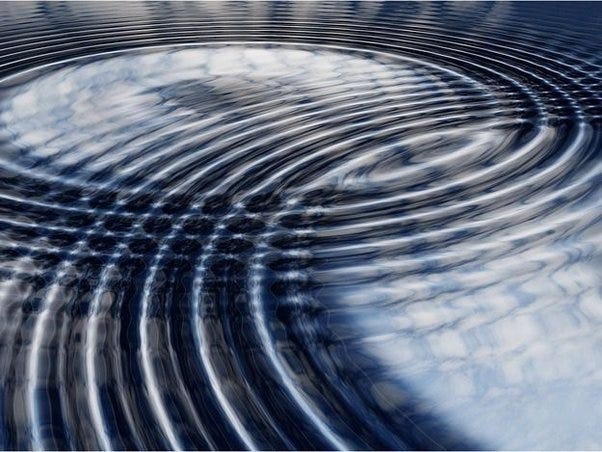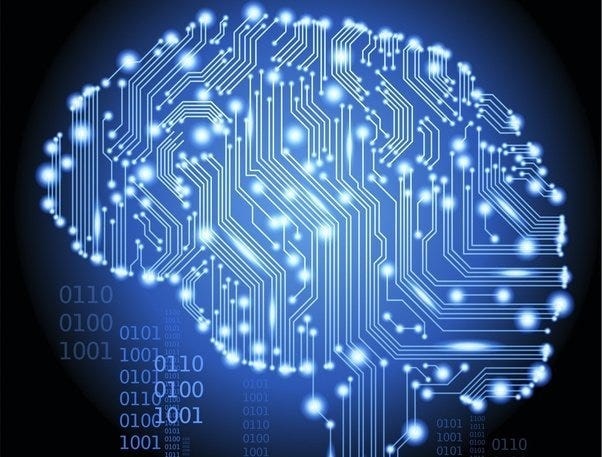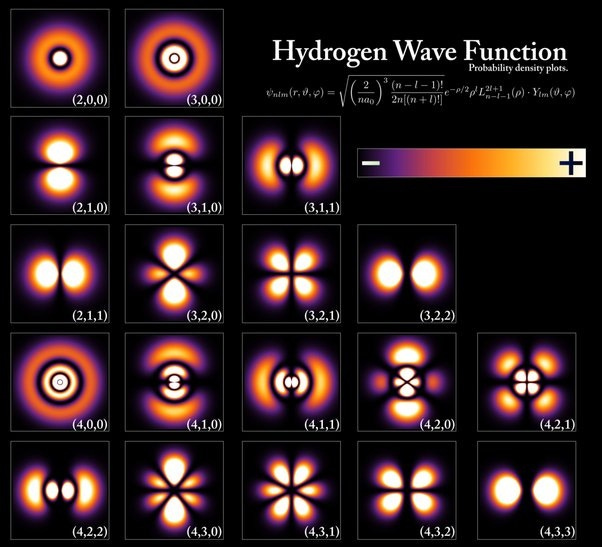Does It Really Occur That When We Don't Look At A Certain Object It Ceases To Exist?
Reconciling the dilemma between particle and quantum physics once and for all.
The objective world does not exist, at least not in the way we are accustomed to believing.
What is “out there” is a vast ocean of waves and frequencies. Reality looks concrete to us only because our brains are able to take this holographic blur and convert it into the “sticks” and “stones” and other familiar objects that make up our world.
This does not mean there aren't “sticks” and “stones” out there. It simply means that a stick or a stone has two very different aspects to its reality. When it is filtered through the lens of our brain it manifests as such. But if we could get rid of our lenses, we'd experience it as an interference pattern.
Which one is real and which is illusion?
Both or neither of them are real, depending how you want to look at it.
In other words, it is not that we create something out of nothing when we look at it, and as soon as we stop looking at it it disappears, but the recognition that in the observed pattern there is an infinity of potential possibilities in which one can see.
A hippo and a human can look at the same thing—let's say it's a tree—and yet, they're not going to see it the same way. Not because of the observed object but because of the mechanism behind that thing that interprets the information.
There Are Many Layers In What Can Be Seen
That thing that we're identified with as who we think we think we are, our conscious mind, can only pay attention to one observational frame at a time.
In each second, consciousness reveals to us a tiny fraction of the eleven million bits of information our senses pass on to our brains.
While the subconscious mind - the intelligence that runs our bodies - is a parallel processor that can view millions of bits of data every second, the conscious mind can only process seven (plus or minus two) bits of data a second.
In this way the mind functions as the analytical sensor, determining what sensory data is allowed to be perceived consciously and what gets pushed below the threshold of the conscious awareness.
The conscious mind performs like a shutter; it takes very fast pictures and then places the information together seamlessly so we don’t notice—just like movies, where the action is not actually a flow of movement but a series of static slides.
If we are looking at an object or information, we can only consciously use less than 0.01 percent of the visible electromagnetic spectrum our eyes can detect. We cannot visually detect simultaneous channels of information because our conscious mind processes information in a “series” format, one slide at a time.
However, because the mind censors what is allowed and what isn’t in our sensory awareness, massive amounts of data are continually deleted and considered negligible by the mind’s innate programming.
This neurological process represents the “doing state” within the problem-set, or in the language of physics, “collapsing the wave functions", as in, “there is something wrong, and I have to do something about it.” This literally determines the difference between the act of observing and the process of interacting.
This process is a set of least-action pathways.
A least-action pathway is a neurological response to learning and then embedding a behavior into the unconscious realm of a habitual response; routes we observe in everyday life.
They are also the pathways for neural information in our brains and nervous systems. By becoming conscious of the world around us, we create these pathways. They become habits necessary for our survival.
Each observation creates a least-action pathway connection with the previous observation. By choosing to observe reality along a particular path, what was unobserved then becomes a greater-action path, even if it would have been a least-action path if it had been observed.
In other words, by choosing to observe a particular path over others, a least action path is created.
Consciousness creates, from all the paths, the one that takes the least action. The way we perceive and construct our reality often constitutes a multitude of least action pathways in our neurology that run automatically in the background.
Least-action pathways are useful, for many activities, not for developing new pathways of cognition.
Electrons Are Neither Particles Nor Waves, But Are They?
One of the things that modern science tends to forget is the 'observer effect' which means that everything that is observed is changed by the very act of observation.
The eminent physicist Werner Heisenberg said,
“Atoms are not things.”
Physical science writer and physicist Nick Herbert extrapolated from Heisenberg’s original statement when he said,
“People are not things in the same way that atoms are not things.”
A body or person is composed structurally of atoms, the conceptual building blocks of all nature. The atom is composed of electrons and the nucleus, which consists of protons and neutrons. But get this: an electron doesn’t actually exist except for when it is observed. When we look at it, only then does the electron assume the semblance of a fixed and stable orbit.
When not being observed, the electron exists in the form of a probability cloud. This cloud is composed of all the probable orbits it could be in before the act of measurement fixes it into a stable orbit around the nucleus.
Electron wave functions in a hydrogen atom at different energy levels. The brighter areas represent a higher probability of finding the electron.
That is where the measurement problem in quantum physics comes in. In order to analyze the data that our experiments generate, we have to use our conscious mind. Our conscious awareness as a serial processor means that we can never see more than one perspective at a given second. In addition, when we observe we entangle the process of our observations with the object or subject of our perceptions.
Together we create a common Morphic Field that takes on a life of its own
Behind every problem is a program. Every program creates and is sustained by its own unique morphic field. The morphic field is created by a person’s beliefs and expectations and how these match his or her opinion of what “should” be.
As soon as we name something, we have defined it. In defining it, we have dictated how it shows up in our reality.
Every time we look at something consciously and attempt to name it and change it, we are applying the same old tired and worn-out model of Newtonian physics in its emphasis of forcing physical reality to conform to the constructs and expectations or world model.
That's why I always remind that, especially in modern science of medicine, we have created more diseases than the actual reality because of the lack of basic understanding how the "naming business" really work. We have no idea of the manner and effect words, names and labels have on how a phenomenon will manifest on the surface.
Thus, we create diseases despite all our good intentions. We cluelessly cause more harm by inventing names and labels that only fixate and anchor the negative characteristics of the symptoms within the individual.
Whenever you artificially describe something with enough detail and conviction, you create a warp bubble or “special case relativity”. The science is “real”—until it’s not real.
The model of your reality holds true until your experiences contradict it too much. When met with experiences that are contradictory to your model, you will either suppress the information into your subconscious or form a new model that includes the contradictory experiences.
You alone can ratify the meaning and quality of your experiences and give them your stamp of authenticity. Because we are different, there is a difference between my perception of the way things work and yours. We therefore choose, through mutual points of agreement, to construct a special relativity model that encompasses or joins together what you and I choose to believe or make up.
Since we, the human species, are meant to form groups and share this relativity between us, which each one of us builds independently, we actually create a shared relative reality in which we decide together what the rules are.
We then formulate what classes of perceptions will drive those rules.
In this way we create a morphic field system that is shared by all. And we teach this system to every generation that comes into the world. This is what makes us different from the rest of the animal and plant kingdoms.
This is the mechanical principle behind esoteric teachings that have tried for millennia to instill in Man the remembrance that they are creators. Not an invisible force up above the sky.
With enough individuals sustaining the consciousness of our special case reality, it functions consistently and reliably.
When this field of consciousness reaches critical mass, a unique morphic field resonance is created. Together we reinforce it by sharing in a set of mutually held beliefs, language and experiences. By that, we create and give life to a quantum reality.
Once this threshold is achieved, the system of thought or belief becomes self-generating and sustaining: “It’s alive!”
This is actually what the ancients used to call 'the Maia‘
Over time we begin to see the same reality because the field of consciousness, which has become self-sustaining automatically confirms to us the limits of consent moment by moment.
That is, least action pathways have taken place within us without our conscious realization, which re-confirms and re-substantiate the system of collective relativity moment by moment; what is allowed and what is not allowed, what makes sense and what does not make, and so on and so forth.
Double-Edged Sword
Its a double-edged sword.
On the one hand we need to invent a mutual relative reality through which we can explain and share mutually agreed concepts with each other. But on the other hand, if we don't know how the mechanism works, it leads to homogeneity: the fact that everyone looks at the same thing and sees the same thing.
Not only do they see the same thing, in our times there is an attempt to apply and enforce the mutually agreed reality on everyone, trying to adapt everyone to the rigidity of our closed systems; to see the same thing.
But only through the ability of each one of us to see uniquely, allows us to develop more and more. If we try to prevent it, however, that means we are also trying to stop our development as a species.
And this is what is happening today. We live in a technocratic age where there is an abundance of information of all kinds. Instead of allowing everything to exist without interruption, there is an attempt to censor what doesn't "fit" the mutual reality.
There is an attempt to impose the consensus as an absolute.
So when someone sees something different they become ridiculed or pressured to conform to how everyone else sees the same thing. And this is an attitude that stems from a complete identification with the mind as the source of being. The same serial processor that processes 0.01 percent of the total information perceived.
We see it a lot with children.
Children in their early years can see or experience things that are beyond the perception of what is in the collective consciousness’ reality bubble.
Their brains have not yet been conditioned to create least-action pathways. They have not yet been assimilated into the 'Maia'. But very quickly, without awareness, adults, be it their parents or their teachers, try to inculcate children into the collective morphic field by which they lose very quickly their inherent unique seeing capabilities with which they came into the world.
What's nice is that these two types of seeing don't have to cancel each other out. They are not mutually exclusive. They do not contradict each other. Both can co-exist and that's the whole beauty. We can still collapse the wave function to another possibility.
In other words, when we meet one another we need this shared framework of language to be able to interact.
When I say "tree" you know exactly what I'm talking about. When we both look at a tree we will see the same thing. But what they don't tell you is that we are designed to be able to look at the same thing, see the same thing and still see something different about it.
We are still free to formulate unique ways to determine the meaning of our experiences within our specially created reality subset.
When we apply a different frame of reference, different information can filter into our conscious awareness. This is one of the best arguments for cultivating the ability to access altered states of consciousness.
Since at the quantum level the act of observing changes the activity of the observed, and since we are all made up of patterns of light, our observations can change by learning a different perception.
If we do not change our set of rules, we will accept the reality that there is no possibility that things will change. This is because we have set things up in our lives in such a way that they should conform to the way we think they should be.
It is no longer done on a conscious level. This is done on an unconscious level. However, it is consciously driven by how we perceive our physical reality.
So if you are a parent of a child, or know a parent of a child, do everything you can to get their attention and educate them about this mechanism; that their child's perceptions - irrational as they may be - should not be limited even though they may seem strange or illogical. This is our gift as humans.
It is our inherent duty to exercise it by encouraging uniqueness: to uniquely collapse the wave function to see something different in the patterns of light and information.
Since you are unique, you represent a unique way to collapse the wave function. And so do I, and so do each and every one of us.
And when each and every one of us does this, we inextricably strengthen and develop the collective field of consciousness because the morphic field is "fed" by us, through the filtering of information and patterns of light in a unique way.
Conclusion:
As we have seen, one of the basic principles of quantum physics is that we do not discover reality, but participate in its creation.
It is possible that as we probe deeper into the levels of reality beyond the atom, the levels where the subtle energies seem to reside, the participatory nature of reality becomes even more apparent.
Therefore we must be extremely careful about saying that we have discovered a particular structure or pattern in the field of consciousness, when in fact we may have created what we found.








To expand a bit more - you reference morphic field in terms of the Maia which I think you see as restricting a more spiritual or abstract awareness but I believe there is a morphic field which connects everyone via morphic resonance at a higher state of consiousness if you like. I have had a large number of personal experiences throughout my life which have led me to belief that there is a 'universal information channel' which anyone, with belief and a mind to do so, can tune into and as a result it seems the universe responds. I am stuggling with words here but there was a film called The Secret by Rhonda Byrne which captured this beautifully.
This article is absolutely fascinating. Have you heard of a book called The dancing Wu Li Masters? I read it decades ago. I just found this summary which explains it better than I could:
'Zukav argues that quantum mechanics and philosophy are inextricable from each other due to their shared pursuit of discerning what the essence of reality is composed of. One example he provides is the mathematical field of probability. Mathematicians in this field use terms such as “probability waves” when trying to figure out the likelihood of a specific event to occur in the physical world. Primarily connecting math and philosophy using specific metaphors in which he tries to pinpoint analogies, Zukav’s argument is that by retroactively seeing these similarities, we can trace the redundancy of thoughts in the history of human thinking to the unconscious self-reflexivity of human thought, which he believes can render the intuition of the past just as valid from the perspective of metaphor as the symbolic formalization of modern physics and math'
https://www.supersummary.com/dancing-wu-li-masters/summary/